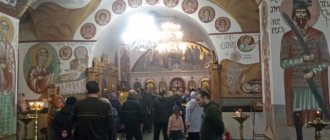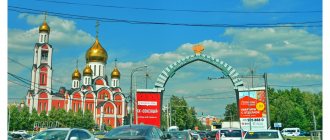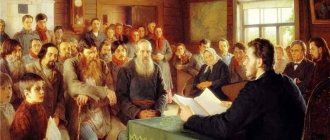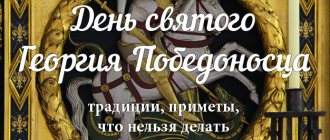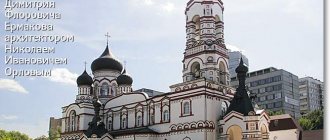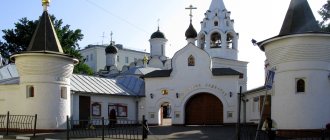The Church of the Holy Great Martyr George the Victorious is one of the inconspicuous sights of Moscow. It is bypassed by excursion tours around the capital. Not even all the indigenous residents of the city know where the Georgian church is located in Moscow. Nevertheless, it exists. And this is not just a temple, of which there are many in Moscow. This is a real little corner of Georgia.
In addition, the church has a very interesting history. And its interiors, as well as its exterior, are worth visiting this temple. And if you are a believer, then you will be interested to know that the church has the status of a patriarchal metochion, which is connected by Christian ties with the Seraphim-Znamensky monastery, the Cathedral of the Kazan Icon of Our Lady in the village of Puchkovo and the chapel of the Virgin Mary of Iveron.
Georgian Church in Moscow: address, how to get there
This temple is located in the central part of the Russian capital, on Presnya. The exact address of the church is Bolshaya Gruzinskaya Street, building 13. As we can see, the spirit of Iberia is present in the names of the places. There are also Malaya Gruzinskaya and Gruzinsky Val streets. As well as the lane and square of the same name. Why is there such an abundance of Georgian streets? We will talk about this below. For now, let’s be clear: many people think that there is a Georgian church in Moscow on Malaya Gruzinskaya Street. But that's not true. Just on Malaya Gruzinskaya there is a spectacular-looking Roman Catholic Church of the Immaculate Conception of the Virgin Mary. It is built in the neo-Gothic style and seems to be a corner of Western Europe in the center of the Russian capital, misleading some citizens.
Now let's return to the Georgian Church of St. George the Victorious. It is extremely easy to get to. You can get out of the metro at the Barrikadnaya station and from there walk or take trolleybus No. 66. An even simpler option for getting to the temple is from the station. metro station "Krasnopresnenskaya". Walk for about ten minutes, constantly moving along the fence of the zoo.
Historical facts
Now it's time to figure out the reason for such frequent Georgian street names in this area. To do this, we need to take a short historical excursion. In the first quarter of the eighteenth century, Georgia was attacked by Türkiye. The Tsar, Vakhtang Levanovich the Sixth, came to Moscow in 1725 to ask for intercession from the Emperor of Russia Peter II. The Georgian monarch did not arrive alone. He was accompanied not only by his sons Bakar and George, but also by a large retinue. In 1729, Peter II granted Vakhtang Levanovich the sovereign's courtyard, which was located on the Presnya River. Then, on the site of the palace of the Georgian king, the merchant V. Gorbunov built a house. In the 70s of the twentieth century, the German Embassy was located in this mansion. Now the house houses the workshop of Zurab Tsereteli.
Well, the retinue of the Georgian king settled not far from their sovereign. Thus, over the course of several years, a fairly large diaspora has formed in Moscow. So big that this entire area on Presnya began to be called simply “Georgians”. That is why the monument to Shota Rustaveli was erected here, in St. George’s Park. But the Georgian church in Moscow appeared, of course, much earlier than the monument to the poet of the twelfth century.
Around Georgian places in Moscow
The village of Voskresenskoye (now Presnensky district) in 1729 was donated to the Georgian king Vakhtang VI, who, together with his retinue, was in exile here. This is how the Georgian Settlement was formed, which existed for a little less than a century. Historical monuments of that time have practically not been preserved. But the toponymy reminds of the Georgian settlement - Bolshaya and Malaya Gruzinskaya streets, Gruzinsky Val, Gruzinskaya Square and Gruzinsky Lane.
Bolshaya Gruzinskaya Street starts from the Moscow Zoo. On its territory, in the shade of trees, there is an inconspicuous wooden house. The building now houses the zoo's security service. However, many employees of the institution do not even suspect that in the 18th century the prince and historian Vakhushti Bagrationi (son of King Vakhtang VI) lived here. During Soviet times, the restored building housed a house-memorial to the history of the Georgian settlement in Moscow in the 17th-18th centuries, but in the 1990s the museum ceased operations. Today the house, despite belonging to cultural heritage sites, is losing its history. It is almost impossible to find any information about him in the public domain.
© photo: Sputnik / Alena Savelyeva
House of Vakhushti Bagrationi in Moscow
Next door to the zoo is the Church of St. George the Victorious in Gruziny, the spiritual center of the Georgian diaspora in Moscow. Once you enter its territory, you move to the “land of eternal spring.” Georgian speech, signs in three languages (Russian, Georgian and English) and, of course, Adjarian khachapuri.
© photo: Sputnik / Alena Savelyeva
Signs in St. George's Square
The first building from the entrance is St. George's Compound. Bread is baked here daily and Georgian cuisine is prepared: from ojakhuri to lobio.
© photo: Sputnik / Alena Savelyeva
St. George's Compound in Moscow
“All our baked goods are made on the premises,” the saleswoman kindly reports. And, indeed, leaving the kitchen, we encounter a man who is carrying another portion of fresh pies. He, like many of the temple servants, is Georgian. But the rector, Father Fedor, is Russian, but he also knows Georgian. He specially mastered it with a teacher, since church services here are conducted in two languages.
© photo: Sputnik / Alena Savelyeva
St. George's Compound in Moscow
The temple servants are sensitive to preserving the history of not only the shrine, but also the entire Georgian settlement. The girl from the church shop, Margarita Khubulia, happily agreed to give us a tour and tell us about the revival of Georgian traditions.
© photo: Sputnik / Alena Savelyeva
St. George's Compound in Moscow
“At the beginning of the 18th century, when the Georgians were settling the settlement, they brought with them a handful of land; it seemed to them that this way they would be closer to their homeland. After all, I had to leave it due to forced circumstances - Georgia was captured by the Turks. Therefore, here in Moscow, Georgians tried to create their own little Georgia with a spiritual center.”
© photo: Sputnik / Alena Savelyeva
Church of St. George the Victorious in Moscow
Interest in the shrine and, in general, in the history of the Georgian settlement appeared quite recently; the building was completely returned to the temple only in 2015. And archaeological excavations today are only gaining momentum. Margarita showed us two gravestones that were found on the territory of the zoo. According to her, their affiliation has not yet been established, but we are talking about the 18th century.
© photo: Sputnik / Alena Savelyeva
18th century gravestones
The temple building consists of two parts - the old one made of white stone and the new one made of red brick. While the exterior of the church needs restoration, the interior decoration dates back to our time. The temple, small on the outside, turns out to be spacious and elegant on the inside. Its walls are painted with images of evangelists and Georgian saints.
© photo: Sputnik / Alena Savelyeva
Church of St. George the Victorious in Moscow
Margarita Khubulia, guide and church minister:
“All the decoration of the church is modern, but the relics of St. George, which were brought to us from Serbia, are kept here. We celebrate all Orthodox holidays, including Georgian ones. Famous Georgian cultural figures often come to the temple - recently, for example, Tamara Gverdtsiteli came, and yesterday Irakli Pirtskhalava came with his children, enrolling the children in the church choir at Sunday school.”
© photo: Sputnik / Alena Savelyeva
Interior decoration of the Church of St. George the Victorious
Today the building is in need of restoration. However, this requires funding. For now, the temple supports itself with the help of donations and funds raised by the St. George's Compound.
© photo: Sputnik / Alena Savelyeva
Interior decoration of the Church of St. George the Victorious
The Church of St. George the Victorious is the only Georgian church in Moscow. However, another temple is associated with Georgian surnames - All Saints in All Saints. It was built on the initiative of the Imeretian princess Daria Archilovna. Until the beginning of the 20th century, church ceremonies were held in the temple in Russian and Georgian. And near the temple there was a Georgian cemetery. Today, only a wall painting depicting Georgian saints - Nino, Tamara and Daria and several memorial plaques in honor of representatives of Georgian princely families reminds of the connection with Georgia.
The Georgian cemetery did not survive, but other burials are located in the tomb of the Georgian kings in the Sretenskaya Church. Under the altar of the Great Cathedral of the Donskoy Monastery lie representatives of the royal Bagration family. You can get there only during church services - morning and evening. Father told us that representatives of the Russian and Georgian Orthodox Churches consecrated the tomb. He also noted that Georgians actively helped in the restoration. In addition, in the tomb you can see icons in the Georgian style and even meet Georgian parishioners. Georgian holidays are not celebrated in the temple, but every year a memorial service is held for the dead.
© photo: Sputnik / Alena Savelyeva
Parishioner of the Georgian Church in Moscow
Returning to Bolshaya Gruzinskaya Street, we say goodbye to spiritual life and plunge into art. Next to the Temple of St. George the Victorious in Gruziny there is a gallery-workshop of Zurab Tsereteli. It can be identified by numerous monuments located near the building. Here we were met by a museum employee who told us how this Tsereteli gallery differs from other Moscow ones (there are about 5 of them in total).
© photo: Sputnik / Alena Savelyeva
Tsereteli Gallery in Moscow
Anna Belyavskaya, museum researcher:
“Our workshop was opened in 1993, but it became a museum only in 2009. The gallery can easily be called “the soul of Tsereteli”; it was here that he actively worked on his works. In addition, Zurab Konstantinovich makes us happy with his presence every day.”
© photo: Sputnik / Alena Savelyeva
Tsereteli Gallery in Moscow
The gallery-workshop presents only Tsereteli’s works. Three floors of paintings, silk-screen printing, enamel, as well as exhibits in plaster, stone and bronze. The exhibition continues outdoors in the museum's courtyard. The scale is truly amazing. The small park contains original monuments and copies of works that have already been installed in many parts of the world. Anna noted that the exhibition is regularly updated. In addition to Moscow, Tsereteli’s works can be found in New York (the “Good Conquers Evil” monument), London (the “Break the Wall of Mistrust” monument), Paris (the bronze sculpture “The Birth of a New Man”) and other cities around the world.
© photo: Sputnik / Alena Savelyeva
Tsereteli Gallery in Moscow
The sculptor does not forget about his native Tbilisi. He presented the Georgian capital with a monument to St. George the Victorious, which is installed on the main square of the city. In addition, in his work, Tsereteli often turns to Georgian motifs.
Anna Belyavskaya, museum researcher:
“Tsereteli has a series of enamels dedicated to the life and everyday life of Tiflis in the 19th century; the works are reminiscent of Pirosmani’s primitivism. Zurab Konstantinovich greatly respects the work of the Georgian artist. By the way, this exhibition can be seen in the courtyard of our museum.”
© photo: Sputnik / Alena Savelyeva
Tsereteli Gallery in Moscow
In Moscow, Tsereteli’s sculptures can be found at almost every turn. For example, 700 meters from the museum, on Tishinskaya Square, there is a monument “Friendship Forever”, dedicated to Russian-Georgian relations. This structure was erected in 1983 to mark the 200th anniversary of the Treaty of Georgievsk. The monument is made in the form of a column, including letters of the Russian and Georgian alphabets. At its base are carved quotes from famous figures of the two countries about friendship and unity.
On Bolshaya Gruzinskaya Street you can also find work by another Georgian sculptor, Merab Berdzenishvili. Next to the gallery-workshop of Zurab Tsereteli, in St. George's Square, stands the monument to Shota Rustaveli. It was installed in 1966 on the occasion of the 800th anniversary of the Georgian statesman and poet. At the foot of the monument there is always a bouquet of yellow roses.
© photo: Sputnik / Alena Savelyeva
Monument to Shota Rustaveli in St. George's Square in Moscow
Today Georgievsky Square is a quiet recreation area. Here, on benches with signs with quotes from Rustaveli, Muscovites and guests of the capital hide from the city noise. However, the seemingly ordinary square is already more than a hundred years old. It was broken in 1898 in honor of Russian-Georgian friendship.
© photo: Sputnik / Alena Savelyeva
Bench with a sign with a quote from Rustaveli in St. George's Square
There are Georgian places in Moscow not only in the Presnensky district (former Gruzinskaya Sloboda). For example, on Kutuzovsky Avenue there is a monument to Peter Bagration, a representative of the royal dynasty of Georgia (Bagrationi) and a participant in the Patriotic War of 1812. The author of the monument was Merab Merabishvili.
© photo: Sputnik / Alena Savelyeva
Monument to Friendship in Moscow
And on Lesnaya Street, near house 55, you can see the sign “Wholesale trade in Kalandadze Caucasian fruits,” which is over a hundred years old. Here in 1905 there was an underground Bolshevik printing house, converted into a fruit shop. However, on the ground floor they actually sold Caucasian fruits and Suluguni cheese. Silovan Kobidze, the store manager, was also a revolutionary and an active participant in strikes.
But the most important Georgian place is the Georgian Embassy on Maly Rzhevsky Lane (formerly Paliashvili Street). The building was built at the beginning of the 20th century. Today the Georgian Interests Section of the Swiss Embassy is located here.
History of the temple
The Iberian diaspora needed a place to worship. The money for the construction of the temple was allocated by Vakhtang’s son, Tsarevich George. The place in the settlement for the sacred building was not chosen by chance. After all, there had previously stood an Orthodox church dedicated to the Evangelist John. But this temple burned down. And in its place the Georgian community built a new wooden church. Already in April 1750, the temple was consecrated by the Georgian archbishop who lived in Russia, Joseph. This church stood for almost thirty years. But wooden structures too often fall victim to fire. This fate did not spare the “Temple on Georgians” either. The community decided to rebuild it in stone.
The new Georgian church in Moscow began to be built in the autumn of 1788, nine years after the fire. After all, it was necessary to write a petition to Metropolitan Platon (Levshin) of the Russian Orthodox Church to obtain permission to build a temple. In 1870, a bell tower was erected.
SIGNIFICANCE OF THE MONUMENT
The building has great urban planning significance, being an organizing element of the surrounding historical buildings.
It is of historical value as a monument to the history of Russian-Georgian relations. Passport
1. NAME OF THE MONUMENT - Church of the Great Martyr George on Presnya.
2. TYPOLOGICAL ASSIGNMENT - architectural monument.
3. DATING - the old church building - 1793-1800, the new building -1900.
4. ADDRESS: MOSCOW, PRESNYA, B. Gruzinskaya st. no. 13.
5. NATURE OF MODERN USE - technical school named after. KRASINA.
6. HISTORICAL INFORMATION:
Historical reference
In 1749, there were 50 Georgian houses on Presnya, which did not belong to any parish church. Georgian priests performed services in house churches.
At the end of the 40s, Tsarevich George built a wooden church and consecrated it in 1750. Bishop Joseph Samebeli before his departure to Kizlyar. The Georgian priest Dmitry Ivanov was identified. In 1779, the church burned down from a burning stove. The sacristy was saved and given over to the Church of the Intercession for storage, and the parishioners were distributed to neighboring parishes. The Georgian settlement was thus left without a parish church./At that time there were 73 Georgian households and 24 Russians/. Nine years after the fire in 1788, Metropolitan Platon received a request from the Georgians to build a new church and at the same time they asked for a Georgian priest. Permission for the construction was given, but they kept silent about the priest. The church was built slowly due to limited funds. For help, the Metropolitan gave the Georgians the abolished Leontief Church on Tverskaya Street with a bell tower with all the utensils and a sacristy.
In 1793, part of the church, the chapel of the Nativity of Christ, was consecrated. In 1800, the entire church was already consecrated. In the Klirovskie Gazette it is written that the church was built with the care of the Moscow merchant Semyon Vasiliev. He also owned the construction of the iconostasis with Greek icons. In 1806-1807, the princes Tsitsianov built a mahogany chapel in the name of Peter and Paul in memory of their brother Pavel Dmitrievich Tsitsianov. They owned more and more valuable things in the church. Mikhail Dmitrievich Tsitsianov was a church patron for 25 years.
The population grew, the temple became cramped. They decided to expand and renovate it. The icons of the Fryazh script were again painted by the icon painter F. A. Sokolov. The new church building in pseudo-Byzantine style was consecrated in 1899. In the church there was a particle of the relics of the Great Martyr George, brought as a gift by Princess E.D. Avalova and embedded in a silver-gilded cross. This particle was acquired by her husband, Prince. G.I. Avalovim in the monastery of St. Great Martyr George. The church had a rich library.
The events of the parish include the establishment of an almshouse in 1819 and the St. George's Home for the Poor Clergy in 1864. The almshouse was established by M.D. Tsitsianov for 8 women. During his life he was supported and after his death by his heirs E.D. Avalova and Princess A.D. Bagration, and since 1864 local rectors of the church.
St. George's House of Charity was built by A.G. Tolstoy, daughter of G.A. Tolstoy, daughter of G.A. Georgian. The parish also housed the girls' school of the Charitable Society of 1837 and the Presnensky orphanage, opened in 1845.
b. Perestroika and losses.
In the 30s of the 20th century, the church was rebuilt as a technical school. The domes and bell tower were destroyed, the window openings were changed, the decor on the windows was destroyed, staircase ceilings were made in the main volume of the building, pilasters on the southern facade were cut off.
V. Restoration No restoration work was carried out.
YouTube Video
Recent history of the church
At the end of the 19th century (1895-1899), the Georgian church in Moscow was completely rebuilt. Architect V. Sretensky increased the size of the temple and gave it the appearance of a Byzantine basilica. This new building was organically adjacent to the old building on the east side. With the advent of Soviet power, difficult times came for the church. In 1922, everything more or less valuable was taken out of it. The bells were removed and the library was plundered.
In 1930, the temple was completely closed. The bell tower was dismantled, and the church building was divided by interfloor ceilings. All this was done in order to install an electromechanical technical school in the religious building. Only in 1933 the old part was returned to believers. An agreement was reached between the Russian and Georgian Orthodox Churches on the joint use of the temple. In 2015, the technical school was evicted from the new part of the building. But much of its former splendor has been lost.
DESCRIPTION OF THE MONUMENT
The original church building is a three-part domed structure with a refectory, a bell tower and chapels. According to the design of the architect N.N. Vasilyeva 1868 -1872 the aisles were expanded by adding altars, extended to the east in line with the main altar, and an additional tier was added to the west. At the end of the 19th century, an additional red brick volume was added to the east. The author of the new church is architect Sretensky.
The entrance gate from the late 19th century and part of the old fence have disappeared. Paintings are hidden under a layer of plaster. The basement of the old church, in the southwestern part, is interesting.
Church of St. George in Moscow
The Georgian community has invested and continues to invest a lot of money to give the desecrated building its former appearance. Now a complete restoration of the old part of the temple is underway. Officially, the Church of St. George belongs to the Russian Orthodox Church, the Moscow Patriarchate. But according to the agreement, the priest of the Georgian Orthodox Church conducts services there. The church also has a refectory and a children's Sunday school. Georgians in Moscow respect their customs and want their children not to forget the traditions of their ancestors. That's why they teach language at school.
It is worth entering under these arches to admire the patterned lectern and the most revered icon of St. George the Victorious, located in a gilded icon case to the right of the altar. The beautiful interior paintings are amazing. The frescoes were made by the famous artist Lasha Kintsurashvili, who specially came from Georgia. They shimmer with bright colors.
